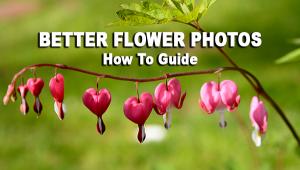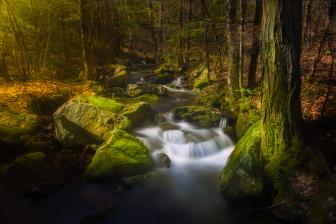Simplify Your Compositions ...it’s simple!
Good photographs needn't be complicated.
You can often make better pictures by thinking "simple."
Instead of trying to get as much as possible into the shot, try to include as little as possible. Ideally, you should include everything that adds to the picture, and nothing else. But that's a tall order for those new to photography (and for a few "old hands."). Thinking "simple" will help you learn to do it.
If you include too much in the picture, the result is confusing. It gives the viewer too much to think about. He or she probably won't even be able to figure out where to start.
A simple composition, on the other hand, allows the viewer to take it in quickly and effortlessly. Then his or her mind can find a starting point for his or her own "tour" of the picture, for their own questions: In the case of the bench photo on the next page, Why is this bench empty? Who is the bench for? What country is this? The viewer's adventure begins.
 |
|
|
The photographer came across a weathered bench in front of a building with some shuttered windows. And that's just what he shows the viewer. He didn't try to include the whole building, or its surroundings. He simplified the photo by including only the bench and two shuttered windows. (He made this photo with an Advanced Photo System point-and-shoot camera, by the way--you don't need fancy gear to get good shots.)
The photographer also composed with the bench to one side. Why? Because the shot "felt" right composed that way. He could have done a symmetrical composition, with the bench centered in the frame, and that might have worked, too, depending on what was to the left of the bench. Perhaps there were distracting elements just out of frame to the left. The shot works wonderfully well composed just as it is.
Maybe there was a color just out of frame that didn't "fit." The colors in the photo work very well together. The colors and the composition give the shot a painterly effect.
Motion pictures are based on the fact that the moviegoer sees only what was included by the director and cinematographer. Everything outside the frame is irrelevant. In fact, if you saw what was just outside the frame in most movie scenes, it would take the magic away. You'd see reflectors and scrims and cue cards and lights and equipment....
One way to keep a composition simple is to use negative space. Negative space is the portion of the composition not occupied by the subject, and as a photographer, you ought to think about it when you shoot.
 |
|
|
Most photographers tend to over-concentrate on their subject, to the detriment of the rest of the image. When composing your images, consider first the subject's location in the frame. Then, examine the rest of the image area. Do the other elements in the picture add to it or detract from it? Are there distracting elements in the background? Perhaps moving the camera right or left (or up or down) will give you a better background. (You can throw distracting background elements out of focus by shooting with the lens set to its largest aperture, but it's better to eliminate the distracting elements from the background if possible.) When shooting action subjects, check the background area before the subjects arrives, and move to a better camera position if necessary to avoid background clutter.
The photo of the white bird has lots of negative space to the right of the subject. This photo could be run large over a spread in a magazine, since it provides lots of room for a head, subhead and body copy (text). When you shoot photos for publication, sometimes it's a good idea to provide some negative space for the art director to use.
When the subject is composed to one side of the image, it's generally best if it faces into the photo, to draw the viewer's eye into the picture rather than out of it. Of course, if this Great Egret were facing the other way (or if the camera had been aimed slightly to the left, so the bird occupied the right half of the image area), besides drawing the viewer's eye out of the picture, it could be construed as an editorial statement that the subject is not interested in (or feels contempt for) the text information inserted into the negative area.
- Log in or register to post comments








































